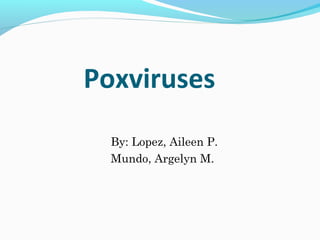
Poxviruses
- 1. Poxviruses By: Lopez, Aileen P. Mundo, Argelyn M.
- 2. Properties of Poxviruses Structure and composition Largest viruses dsDNA, 130-375 kb Brick shaped “dumbbell” core (contains nucleic acid) Lateral bodies (unknown function) Enveloped Resistant to inactivation More than 100 polypeptides Many target the immune response Replicate in cytoplasm Tend to be highly species-specific Some are being explored as gene therapy vectors Core Envelope Lateral bodies
- 3. Classification Family Poxviridae Subfamilies Genera Members Chordopoxvirinae Orthopoxvirus Variola, vaccinia, cowpox, monkeypox, camelpox (vertebrates) Parapoxvirus Sealpox, parapox of deer, pseudocowpox Avipoxvirus Canarypox, fowlpox, pigeonpox, turkeypox, penguinpox Capripoxvirus Goatpox, sheeppox Leporipoxvirus Hare fibroma, myoma, rabbit fibroma, squirrel fibroma Suipoxvirus Swinepox Molluscipoxvirus Molluscum contagium Yatapoxvirus Tanapox, Yaba monkey tumor Entomopoxvirinae Capripoxvirus A (insects) Capripoxvirus B Capripoxvirus C
- 4. Poxviruses Include the human viruses variola (smallpox) and molluscum contagiosum Some viruses naturally infect animals and can cause incidental infection in humans (zoonosis). Many of these viruses share antigenic determinants with smallpox, allowing the use of an animal poxvirus for a human vaccine.
- 5. The largest viruses, almost visible on light microscopy (300 nm) and are ovoid to brick shaped with a complex morphology.
- 6. Replication Attachment, penetration and uncoating Membrane fusion Viral core dissociates, releasing Viral DNA Viral enzymes Virally-encoded RNA polymerase (prepackaged) synthesizes early mRNA Early proteins DNA polymerase Thymidine kinase Recombinase? Maturation Structural proteins are synthesized Virus synthesizes its own membranes Some virus exits by budding, but most when the cell dies
- 8. Pathogenesis and Immunity After being inhaled, smallpox virus replicates in the upper respiratory tract. Dissemination occurs via lymphatic and cellassociated viremic spread. Internal and dermal tissues are inoculated after a second viremia, causing the simultaneous eruption of the characteristic "pocks.“ Molluscum contagiosum and the other poxviruses, however, are acquired through direct contact with lesions.
- 10. Epidemiology Smallpox and molluscum contagiousum are strictly human viruses. In contrast, the natural hosts for the other poxviruses important to humans are vertebrates other than humans (e.g., cow, sheep, goats). The viruses infect humans only through accidental or occupational exposure (zoonosis).
- 11. Clinical Syndromes Smallpox Named smallpox to discriminate it from largepox (syphilis) No animal reservoir Two species Variola major (20% fatality) Variola minor (1-2% fatality) Smallpox has shaped civilization Earliest evidence: Egyptian mummies Ramses V (1157 BC) Introduced to the Americas by European explorers British army used smallpox as a biological weapon against the Pontiac Indians About 40 million native Americans died from European diseases, including smallpox Native Americans have limited MHC polymorphisms Killed 300 million people in the 20th century alone Total fatalities probably near 1 billion
- 12. Control and Eradication Vaccine Smallpox Edward Jenner observed that milkmaids rarely contracted smallpox All had recalled earlier cowpox infections, which were nearly universal in milkmaids Cowpox only causes a mild infection in humans Jenner hypothesized that the infectious agent of cowpox protected against smallpox He inoculated a nephew by scarification with cowpox crusts termed variolation Today’s vaccine is live attenuated vaccinia virus Vaccinia’s genome looks similar to cowpox, but it is not identical In the 1950s, the Soviets proposed a global eradication program to the United Nations Some have suggested that the Soviets had a vaccine-resistant strain of variola, which could be used as a bioweapon The World Health Organization (WHO) Intensified Smallpox Eradication Programme program began in 1967 Smallpox was declared eradicated in 1980 (last case in 1977) Only two nations are supposed to have smallpox viruses today United States (CDC-Atlanta) Russia (VECTOR, Moscow)
- 13. Smallpox Pathogenesis Respiratory transmission Incubation period 10-14 days After day 7 or so, humans begin shedding virus asymptomatically Principal reason for rapid spread Outbreaks tended to be in clusters Allowed the ring immunization containment strategy during the eradication program Clinical symptoms Fever Malaise Centrifugally-distributed exanthems macules papules pustules
- 15. VACCINIA Vaccinia, a form of cowpox, was used for the smallpox vaccine. The vaccination procedure consisted of scratching live virus into the patient's skin and then observing for the development of vesicles and pustules. Encephalitis and progressive infection (vaccinia necrosum), the latter occurring occasionally in immunocompromised patients
- 16. ORF, COWPOX, AND MONKEYPOX Human infection with the orf (poxvirus of sheep and goat) or cowpox (vaccinia) virus is usually an occupational hazard resulting from direct contact with the lesions on the animal. A single nodular lesion usually forms on the point of contact, such as the fingers, hand and is hemorrhagic or granulomatous. Then regress in 25 to 35 days, generally without scar formation. The lesions may be mistaken for anthrax. Monkeypox causes a milder version of smallpox disease.
- 17. Orf
- 18. MOLLUSCUM CONTAGIOSUM The lesions differ significantly from pox lesions in being nodular to wartlike. Begin as papules and then become pearl-like, umbilicated nodules that have a central caseous plug. The incubation period for molluscum contagiosum is 2 to 8 weeks, and the disease is spread by direct contact (e.g., sexual contact, wrestling) or fomites (e.g., towels).
- 19. MOLLUSCUM CONTAGIOSUM They are most common on the trunk, genitalia, and proximal extremities and usually occur in a cluster of five to 20 nodules. The disease is more common in children than adults, but its incidence is increasing in sexually active individuals.
- 20. Diagnosis Confirmed histologically by the finding of characteristic large, eosinophilic cytoplasmic inclusions (molluscum bodies) in epithelial cells. These bodies can be seen in biopsy specimens
- 21. Epidermis is filled with molluscum bodies
- 22. Lesions of molluscum contagiosum disappear in 2 to 12 months, presumably as a result of immune responses. The nodules can be removed by curettage (scraping) or the application of liquid nitrogen or iodine solutions.
- 23. THANK YOU!!!!!
